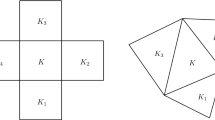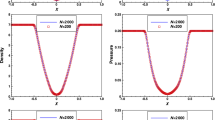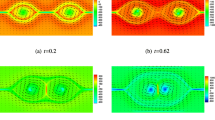Abstract
We propose and analyze a class of robust, uniformly high-order accurate discontinuous Galerkin (DG) schemes for multidimensional relativistic magnetohydrodynamics (RMHD) on general meshes. A distinct feature of the schemes is their physical-constraint-preserving (PCP) property, i.e., they are proven to preserve the subluminal constraint on the fluid velocity and the positivity of density, pressure, and internal energy. This is the first time that provably PCP high-order schemes are achieved for multidimensional RMHD. Developing PCP high-order schemes for RMHD is highly desirable but remains a challenging task, especially in the multidimensional cases, due to the inherent strong nonlinearity in the constraints and the effect of the magnetic divergence-free condition. Inspired by some crucial observations at the PDE level, we construct the provably PCP schemes by using the locally divergence-free DG schemes of the recently proposed symmetrizable RMHD equations as the base schemes, a limiting technique to enforce the PCP property of the DG solutions, and the strong-stability-preserving methods for time discretization. We rigorously prove the PCP property by using a novel “quasi-linearization” approach to handle the highly nonlinear physical constraints, technical splitting to offset the influence of divergence error, and sophisticated estimates to analyze the beneficial effect of the additional source term in the symmetrizable RMHD system. Several two-dimensional numerical examples are provided to further confirm the PCP property and to demonstrate the accuracy, effectiveness and robustness of the proposed PCP schemes.








Similar content being viewed by others
Notes
The PCP property defined in this paper refers only to the preservation of the subluminal constraint on fluid velocity and the positivity of density, pressure, and internal energy. Our PCP definition does not include the divergence-free constraint (4). The numerical schemes proposed in this paper only maintain a locally divergence-free property for the magnetic field.
References
Balsara, D.S.: Second-order-accurate schemes for magnetohydrodynamics with divergence-free reconstruction. Astrophys. J. Suppl. Ser. 151, 149–184 (2004)
Balsara, D.S., Kim, J.: A subluminal relativistic magnetohydrodynamics scheme with ADER-WENO predictor and multidimensional Riemann solver-based corrector. J. Comput. Phys. 312, 357–384 (2016)
Balsara, D.S., Spicer, D.: A staggered mesh algorithm using high order Godunov fluxes to ensure solenoidal magnetic fields in magnetohydrodynamic simulations. J. Comput. Phys. 149, 270–292 (1999)
Chandrashekar, P.: A global divergence conforming DG method for hyperbolic conservation laws with divergence constraint. J. Sci. Comput. 79(1), 79–102 (2019)
Christlieb, A.J., Liu, Y., Tang, Q., Xu, Z.: Positivity-preserving finite difference weighted ENO schemes with constrained transport for ideal magnetohydrodynamic equations. SIAM J. Sci. Comput. 37(4), A1825–A1845 (2015)
Cockburn, B., Hou, S., Shu, C.W.: The Runge–Kutta local projection discontinuous Galerkin finite element method for conservation laws. IV. The multidimensional case. Math. Comput. 54(190), 545–581 (1990)
Cockburn, B., Li, F., Shu, C.W.: Locally divergence-free discontinuous Galerkin methods for the Maxwell equations. J. Comput. Phys. 194(2), 588–610 (2004)
Cockburn, B., Shu, C.W.: TVB Runge–Kutta local projection discontinuous Galerkin finite element method for conservation laws. II. General framework. Math. Comput. 52(186), 411–435 (1989)
Dedner, A., Kemm, F., Kröner, D., Munz, C.D., Schnitzer, T., Wesenberg, M.: Hyperbolic divergence cleaning for the MHD equations. J. Comput. Phys. 175(2), 645–673 (2002)
Del Zanna, L., Zanotti, O., Bucciantini, N., Londrillo, P.: ECHO: a Eulerian conservative high-order scheme for general relativistic magnetohydrodynamics and magnetodynamics. Astron. Astrophys. 473(1), 11–30 (2007)
Du, J., Shu, C.W.: Positivity-preserving high-order schemes for conservation laws on arbitrarily distributed point clouds with a simple WENO limiter. Int. J. Numer. Anal. Model. 15, 1–25 (2018)
Evans, C.R., Hawley, J.F.: Simulation of magnetohydrodynamic flows: a constrained transport method. Astrophys. J. 332, 659–677 (1988)
Fu, P., Li, F., Xu, Y.: Globally divergence-free discontinuous Galerkin methods for ideal magnetohydrodynamic equations. J. Sci. Comput. 77(3), 1621–1659 (2018)
Godunov, S.K.: Symmetric form of the equations of magnetohydrodynamics. Numer. Methods Mech. Contin. Medium 1, 26–34 (1972)
Gottlieb, S., Shu, C.W., Tadmor, E.: Strong stability-preserving high-order time discretization methods. SIAM Rev. 43(1), 89–112 (2001)
Guermond, J.L., Nazarov, M., Popov, B., Tomas, I.: Second-order invariant domain preserving approximation of the Euler equations using convex limiting. SIAM J. Sci. Comput. 40(5), A3211–A3239 (2018)
He, P., Tang, H.: An adaptive moving mesh method for two-dimensional relativistic magnetohydrodynamics. Comput. Fluids 60, 1–20 (2012)
van der Holst, B., Keppens, R., Meliani, Z.: A multidimensional grid-adaptive relativistic magnetofluid code. Comput. Phys. Commun. 179(9), 617–627 (2008)
Hu, X.Y., Adams, N.A., Shu, C.W.: Positivity-preserving method for high-order conservative schemes solving compressible Euler equations. J. Comput. Phys. 242, 169–180 (2013)
Jiang, Y., Liu, H.: Invariant-region-preserving DG methods for multi-dimensional hyperbolic conservation law systems, with an application to compressible Euler equations. J. Comput. Phys. 373, 385–409 (2018)
Komissarov, S.S.: A Godunov-type scheme for relativistic magnetohydrodynamics. Mon. Not. R. Astron. Soc. 303(2), 343–366 (1999)
Krivodonova, L., Xin, J., Remacle, J.F., Chevaugeon, N., Flaherty, J.E.: Shock detection and limiting with discontinuous Galerkin methods for hyperbolic conservation laws. Appl. Numer. Math. 48(3–4), 323–338 (2004)
Li, F., Shu, C.W.: Locally divergence-free discontinuous Galerkin methods for MHD equations. J. Sci. Comput. 22(1–3), 413–442 (2005)
Li, F., Xu, L., Yakovlev, S.: Central discontinuous Galerkin methods for ideal MHD equations with the exactly divergence-free magnetic field. J. Comput. Phys. 230(12), 4828–4847 (2011)
Liang, C., Xu, Z.: Parametrized maximum principle preserving flux limiters for high order schemes solving multi-dimensional scalar hyperbolic conservation laws. J. Sci. Comput. 58(1), 41–60 (2014)
Ling, D., Duan, J., Tang, H.: Physical-constraints-preserving Lagrangian finite volume schemes for one- and two-dimensional special relativistic hydrodynamics. J. Comput. Phys. 396, 507–543 (2019)
Mignone, A., Bodo, G.: An HLLC riemann solver for relativistic flows—II. magnetohydrodynamics. Mon. Not. R. Astron. Soc. 368(3), 1040–1054 (2006)
Mishra, S., Tadmor, E.: Constraint preserving schemes using potential-based fluxes. III. Genuinely multi-dimensional schemes for MHD equations. ESAIM: Math. Model. Numer. Anal. 46(3), 661–680 (2012)
Powell, K.G.: An approximate Riemann solver for magnetohydrodynamics (that works in more than one dimension). Technical Report. ICASE Report No. 94-24, NASA Langley, VA (1994)
Powell, K.G., Roe, P.L., Linde, T.J., Gombosi, T.I., Zeeuw, D.L.D.: A solution-adaptive upwind scheme for ideal magnetohydrodynamics. J. Comput. Phys. 154(2), 284–309 (1999)
Qin, T., Shu, C.W., Yang, Y.: Bound-preserving discontinuous Galerkin methods for relativistic hydrodynamics. J. Comput. Phys. 315, 323–347 (2016)
Qiu, J., Shu, C.W.: Runge–Kutta discontinuous Galerkin method using WENO limiters. SIAM J. Sci. Comput. 26(3), 907–929 (2005)
Radice, D., Rezzolla, L., Galeazzi, F.: High-order fully general-relativistic hydrodynamics: new approaches and tests. Class. Quantum Gravity 31(7), 075012 (2014)
Shu, C.W.: Bound-preserving high-order schemes for hyperbolic equations: survey and recent developments. In: Klingenberg, C., Westdickenberg, M. (eds.) Theory, Numerics and Applications of Hyperbolic Problems II, pp. 591–603. Springer, Cham (2018)
Sun, Z., Shu, Cw.: Strong stability of explicit Runge–Kutta time discretizations. SIAM J. Numer. Anal. 57(3), 1158–1182 (2019)
Tadmor, E.: A minimum entropy principle in the gas dynamics equations. Appl. Numer. Math. 2(3), 211–219 (1986)
Torrilhon, M.: Locally divergence-preserving upwind finite volume schemes for magnetohydrodynamic equations. SIAM J. Sci. Comput. 26(4), 1166–1191 (2005)
Tóth, G.: The \(\nabla \cdot {B} = 0\) constraint in shock-capturing magnetohydrodynamics codes. J. Comput. Phys. 161(2), 605–652 (2000)
Wu, K.: Design of provably physical-constraint-preserving methods for general relativistic hydrodynamics. Phys. Rev. D 95(10), 103001 (2017)
Wu, K.: Positivity-preserving analysis of numerical schemes for ideal magnetohydrodynamics. SIAM J. Numer. Anal. 56(4), 2124–2147 (2018)
Wu, K.: Minimum principle on specific entropy and high-order accurate invariant region preserving numerical methods for relativistic hydrodynamics. arXiv preprint arXiv:2102.03801 (2021)
Wu, K., Shu, C.W.: A provably positive discontinuous Galerkin method for multidimensional ideal magnetohydrodynamics. SIAM J. Sci. Comput. 40(5), B1302–B1329 (2018)
Wu, K., Shu, C.W.: Provably positive high-order schemes for ideal magnetohydrodynamics: analysis on general meshes. Numer. Math. 142(4), 995–1047 (2019)
Wu, K., Shu, C.W.: Entropy symmetrization and high-order accurate entropy stable numerical schemes for relativistic MHD equations. SIAM J. Sci. Comput. 42(4), A2230–A2261 (2020)
Wu, K., Tang, H.: High-order accurate physical-constraints-preserving finite difference WENO schemes for special relativistic hydrodynamics. J. Comput. Phys. 298, 539–564 (2015)
Wu, K., Tang, H.: Admissible states and physical-constraints-preserving schemes for relativistic magnetohydrodynamic equations. Math. Models Methods Appl. Sci. 27(10), 1871–1928 (2017)
Wu, K., Tang, H.: Physical-constraint-preserving central discontinuous Galerkin methods for special relativistic hydrodynamics with a general equation of state. Astrophys. J. Suppl. Ser. 228(1), 3 (2017)
Wu, K., Tang, H.: On physical-constraints-preserving schemes for special relativistic magnetohydrodynamics with a general equation of state. Z. Angew. Math. Phys. 69(3), 84 (2018)
Xu, Z.: Parametrized maximum principle preserving flux limiters for high order schemes solving hyperbolic conservation laws: one-dimensional scalar problem. Math. Comput. 83(289), 2213–2238 (2014)
Xu, Z., Liu, Y.: New central and central discontinuous Galerkin schemes on overlapping cells of unstructured grids for solving ideal magnetohydrodynamic equations with globally divergence-free magnetic field. J. Comput. Phys. 327, 203–224 (2016)
Zanotti, O., Fambri, F., Dumbser, M.: Solving the relativistic magnetohydrodynamics equations with ADER discontinuous Galerkin methods, a posteriori subcell limiting and adaptive mesh refinement. Mon. Not. R. Astron. Soc. 452(3), 3010–3029 (2015)
Zhang, X.: On positivity-preserving high order discontinuous Galerkin schemes for compressible Navier–Stokes equations. J. Comput. Phys. 328, 301–343 (2017)
Zhang, X., Shu, C.W.: On maximum-principle-satisfying high order schemes for scalar conservation laws. J. Comput. Phys. 229(9), 3091–3120 (2010)
Zhang, X., Shu, C.W.: On positivity-preserving high order discontinuous Galerkin schemes for compressible Euler equations on rectangular meshes. J. Comput. Phys. 229(23), 8918–8934 (2010)
Zhang, X., Shu, C.W.: A minimum entropy principle of high order schemes for gas dynamics equations. Numer. Math. 121(3), 545–563 (2012)
Zhang, X., Xia, Y., Shu, C.W.: Maximum-principle-satisfying and positivity-preserving high order discontinuous Galerkin schemes for conservation laws on triangular meshes. J. Sci. Comput. 50(1), 29–62 (2012)
Zhao, J., Tang, H.: Runge–Kutta discontinuous Galerkin methods for the special relativistic magnetohydrodynamics. J. Comput. Phys. 343, 33–72 (2017)
Zou, S., Yu, X., Dai, Z.: A positivity-preserving Lagrangian discontinuous Galerkin method for ideal magnetohydrodynamics equations in one-dimension. J. Comput. Phys. 405, 109144 (2020)
Author information
Authors and Affiliations
Corresponding author
Additional information
Publisher's Note
Springer Nature remains neutral with regard to jurisdictional claims in published maps and institutional affiliations.
Research of C.-W. Shu is supported in part by NSF grants DMS-1719410 and DMS-2010107, and AFOSR grant FA9550-20-1-0055.
Appendices
Proof of Proposition 1
Due to the assumption that the exact smooth solution exists for \({\varvec{x}} \in {{\mathbb {R}}}^d\) and \(0\le t \le T\), the Lorentz factor W does not blow up, and then \(|\mathbf{v }( {\varvec{x}}, t )|<1\) for \(\forall {\varvec{x}} \in {{\mathbb {R}}}^d\) and \(0\le t \le T\). For any \(\left( {\bar{\varvec{x}}}, {\bar{t}} \right) \in {\mathbb {R}}^d \times {\mathbb {R}}^+\), we denote by \({\varvec{x}}={\varvec{x}}(t;\bar{\varvec{x}},{\bar{t}})\) the integral curve of \( \frac{d {\varvec{x}}}{d t} = \mathbf{v } ({\varvec{x}},t) \) through the point \(\left( {\bar{\varvec{x}}}, {\bar{t}} \right) \). Define \({\varvec{x}}_0( \bar{\varvec{x}},{\bar{t}} ):= {\varvec{x}}(0;\bar{\varvec{x}},{\bar{t}})\). It can be observed that the curve passes through the point \(\left( {\varvec{x}}_0( \bar{\varvec{x}},{\bar{t}} ),0 \right) \) at the initial time \(t=0\). For strong solutions, we can reformulate the continuity equation of (10) for \(\rho W\) as \( \frac{ {\mathcal {D}}(\rho W) }{{\mathcal {D}}t} = - \rho W \nabla \cdot \mathbf{v }, \) where \(\frac{{\mathcal {D}}}{{\mathcal {D}}t}:= \frac{\partial }{\partial t} + \mathbf{v }({\varvec{x}},t) \nabla \cdot \) denotes the derivative along the integral curve. Integration of this reformulated continuity equation from \(t=0\) to \({\bar{t}}\) along the curve implies
which, along with \(W ( {\bar{\varvec{x}}}, {\bar{t}} ) \ge 1\), imply \(\rho ( {\bar{\varvec{x}}}, {\bar{t}} )>0\) for all \(\left( {\bar{\varvec{x}}}, {\bar{t}} \right) \in {\mathbb {R}}^3 \times {\mathbb {R}}^+\). For smooth solutions of the modified RMHD system (10), one can derive that
which implies \( p \rho ^{-\varGamma } ( {\bar{\varvec{x}}}, {\bar{t}} ) = p_0 \rho ^{-\varGamma }_0 ( {\varvec{x}}_0( \bar{\varvec{x}},{\bar{t}} ) ) > 0. \) It follows that \(p ( {\bar{\varvec{x}}}, {\bar{t}} ) >0,~\forall \left( {\bar{\varvec{x}}}, {\bar{t}} \right) \in {\mathbb {R}}^3 \times {\mathbb {R}}^+\). Using the ideal EOS (3) with \(\varGamma \in (1,2]\) gives \(e ({\bar{\varvec{x}}}, {\bar{t}}) = \frac{1}{\varGamma -1} p ({\bar{\varvec{x}}}, {\bar{t}})/\rho ({\bar{\varvec{x}}}, {\bar{t}}) >0\), \(\forall \left( {\bar{\varvec{x}}}, {\bar{t}} \right) \in {\mathbb {R}}^3 \times {\mathbb {R}}^+\). It has been shown in [44] that, for smooth solutions of (10), the quantity \(\frac{\nabla \cdot \mathbf{B }}{\rho W}\) satisfies
which implies that \(\frac{\nabla \cdot \mathbf{B }}{\rho W}\) remains constant along the integral curve \({\varvec{x}}={\varvec{x}}(t;\bar{\varvec{x}},{\bar{t}})\), and further yields (13). The proof is completed. \(\square \)
Proof of Theorem 2
For the first-order DG method (\(k=0\)), \(\mathbf{U }_h |_K ({\varvec{x}}) \equiv {{\bar{\mathbf{U }}}}_K\), \(\forall K \in {{\mathcal {T}}}_h\), and
where the identity \(\sum \limits _{ {{\mathscr {E}}} \in \partial K } |{{\mathscr {E}}}| \mathbf{n }_{{{\mathscr {E}}},K} = \mathbf{0 }\) has been used. In order to prove the PCP property (31), it suffices to show
under the CFL type condition (52) and the condition that \({{\bar{\mathbf{U }}}}_K \in {{\mathcal {G}}},~\forall K \in {{\mathcal {T}}}_h\). In the following, we prove (63) by using the second equivalent form \({{\mathcal {G}}}_2={{\mathcal {G}}}\) in Lemma 2 and verifying that \({{\bar{\mathbf{U }}}}_K^{\varDelta t} \in {{\mathcal {G}}}_2\), \(\forall K \in {{\mathcal {T}}}_h\).
We first show that the mass density \({\bar{D}}_K^{\varDelta t}>0\). Recalling that the first component of \(\mathbf{S }(\mathbf{U })\) is zero, we know that the first component of \(\widetilde{{\mathcal {J}}}_K^{(2)}\) is zero. Then, we obtain
where we have used the CFL condition (52) and \(\langle \mathbf{n }_{{{\mathscr {E}}},K}, {\bar{\mathbf{v }}}_{ K_{{\mathscr {E}}}} \rangle \le | {\bar{\mathbf{v }}}_{ K_{{\mathscr {E}}}} | < 1 = c =a\).
We then prove that \({{\bar{\mathbf{U }}}}_K^{\varDelta t} \cdot {{ {\varvec{\xi }}^*}} + {p^*_m} >0\) for any auxiliary variables \(\mathbf{B }^* \in {\mathbb {R}}^3 \) and \(\mathbf{v }^* \in {\mathbb {B}}_1(\mathbf{0 })\), where \({\varvec{\xi }}^*\) and \({p^*_m}\) are functions of \((\mathbf{B }^*,\mathbf{v }^*)\) as defined in Lemma 2. Using the inequality (23) in Lemma 6 gives
It, along with (61), imply that
where the identity \(\sum \limits _{ {{\mathscr {E}}} \in \partial K } |{{\mathscr {E}}}| \mathbf{n }_{{{\mathscr {E}}},K} = \mathbf{0 }\) has been used in the last equality. Combining (62) and the above estimate, we obtain
Thanks to Lemma 4, we obtain
where the identity \(\sum \limits _{ {{\mathscr {E}}} \in \partial K } |{{\mathscr {E}}}| \mathbf{n }_{{{\mathscr {E}}},K} = \mathbf{0 }\) has been used in the equality, and the CFL condition (52) is used in the last inequality. Therefore, we have
which, along with \({\bar{D}}_K^{\varDelta t}>0\), yield \({{\bar{\mathbf{U }}}}_K^{\varDelta t} \in {{\mathcal {G}}}_2 = {{\mathcal {G}}}\). The proof is completed. \(\square \)
Rights and permissions
About this article
Cite this article
Wu, K., Shu, CW. Provably physical-constraint-preserving discontinuous Galerkin methods for multidimensional relativistic MHD equations. Numer. Math. 148, 699–741 (2021). https://doi.org/10.1007/s00211-021-01209-4
Received:
Revised:
Accepted:
Published:
Issue Date:
DOI: https://doi.org/10.1007/s00211-021-01209-4




